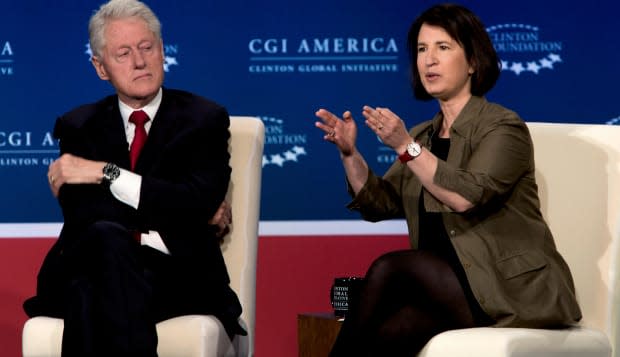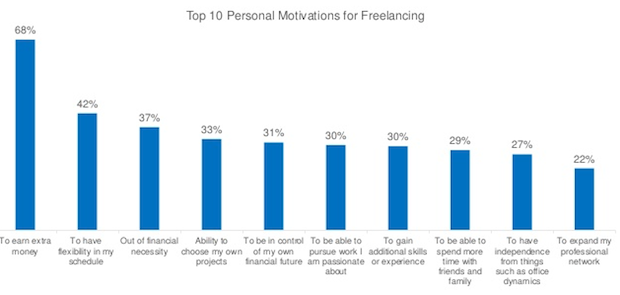Freelance: Increasingly It's How America Works

Freelance work is not a passing trend. And contrary to conventional wisdom, a majority of freelancers are quite satisfied and enjoy the flexibility and control they get from putting their eggs in more than one basket.
That's the conclusion of a new research study: "Freelancing in America: A National Survey of the New Workforce," commissioned by Freelancers Union and Elance-Odesk, two organizations with a vested interest in the success of freelancers.
The research, conducted by Edelman Berland, counts 53 million people doing freelance work in the U.S. – or 34 percent of the national workforce. They are a powerful economic force, contributing an estimated $715 billion in earnings to the economy.
It's been nearly a decade since the U.S. General Accounting Office took a census of so-called "contingent workers" and counted 42.6 million.
Sara Horowitz, founder of Freelancers Union, said a driving motivation behind the research was to find out how freelancers feel about their status. The positive-leaning results, she says, are a counter to the black and white all bad/all good extremes in the general market.
"This is a story about work in America. What we're trying to say is this is the new reality," Horowitz told AOL Jobs. "It's a wakeup call. What will be the things that make people flourish?"

Of the freelancers in the 5,000+ working Americans surveyed, 32 percent have seen an increase in demand vs. 15 percent experiencing a decline. Technology has made it easier to find work and the primary drivers are earning extra money and schedule flexibility.
The research found that 80 percent of non-freelancers would be willing to do work outside their primary job to make more money. And 36 percent of the moonlighters who have a primary job have thought of quitting to go totally independent, representing 5.1 million people.
Millennials are freelancing more than any other age group and are most optimistic about it. They are also a generation who have experienced no other world of work.
The result of a more flexible workforce is more meaningful and independent lives for workers and the ability to access the right skills and people at the right time for businesses, the researchers conclude.
A more nimble economy is potentially more innovative, more competitive, and better able to deal with the fluctuations of global markets.
Among the stats:
43 percent of freelancers expect their income to increase vs. 11 percent who expect it to decrease.
Nearly 8 in 10 , or 77 percent, say they make the same or more money than they did before freelancing and 42 percent already make more.
The research identifies five classifications of freelancer, the dominant being the independent contractor who has no permanent employer and does freelance, temporary or supplemental work on a project-to-project basis.
Some 9.3 million qualify as diversified workers. This would be the person who works at a dentist's office 20 hours a week and fills out their income by driving for Uber and doing freelance writing.

"People are adjusting their expenses and working in the way that lets them have control," says Horowitz. "Previously, employers had all the control." As an advocacy organization for independent workers, Freelancers Union also provides insurance and medical benefits to freelancers.
"Why do we think a more flexible career is good for individuals? There is so much change. Rapidly rising and declining skills. Increasingly shorter tenure."
For starters, Horowitz says, the government safety nets in place, such as unemployment insurance, have been made for the old manufacturing days of longterm joblessness.
In a freelance economy, it is less likely for a worker to lose all their income at one time, but they might need a cash infusion for a short burst between gigs.
According to Elance-Odesk CEO Fabio Rosati, the company's database of freelancers looking for projects is weighted to highly educated knowledge workers, dominated by technical, creative and administrative types. These are professionals with a lot of project-related work.

Just like small businesses, freelancers express a need for access to capital to grow. Their biggest needs are compatible with those of the small business entrepreneur: stable income, easier ways to get new clients and more reliable ways to receive payment.
"Being a freelancer and independent is about being a micro-entrepreneur," Rosati says. "Freelancers are the smallest business you can imagine."
What's also needed, Horowitz says, is for government to shed more light on skills in demand and support new ways to acquire those skills.
The opportunity is big, she adds, for regional metro areas to plan and identify a way to attract the freelance workforce just as co-working spaces are springing up around the country to support independent workers who want to bounce ideas off others.

